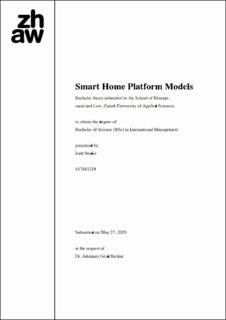Please use this identifier to cite or link to this item:
https://doi.org/10.21256/zhaw-21974| Publication type: | Bachelor thesis |
| Title: | Smart home platform models |
| Authors: | Studer, Jorit |
| Advisors / Reviewers: | Becker, Johannes Gerd |
| DOI: | 10.21256/zhaw-21974 |
| Extent: | 66 |
| Issue Date: | 2020 |
| Publisher / Ed. Institution: | ZHAW Zürcher Hochschule für Angewandte Wissenschaften |
| Publisher / Ed. Institution: | Winterthur |
| Language: | English |
| Subject (DDC): | 658.1: Organization and finance |
| Abstract: | Over the last hundred years, there has been a trend in domestic technology. At a conference in 1984, the National Association of Home Builders introduced the smart house concept. The synonym smart home used today was introduced by researchers years later. Today the smart home market is relatively fragmented as numerous companies are involved, operating in different sectors of the economy. As a result, a variety of technologies and software protocols are deployed, which represents a significant barrier to the development of smart appliances. In the early 2000s, the concept of a two-sided platform gained traction. Rochet and Tirole were among the first researchers to propose a paper on two-sided markets with network externalities. The concept describes that a two- or multisided platform coordinates interactions or transactions of different users and, thus, acts as an intermediary. The primary objective of this thesis was to determine to what extent key global smart home companies are compliant with literature definitions and concepts on platforms. Therein, the focus was to identify their business models and strategies applied. In the literature review, a theoretical understanding was established through a comprehensive examination of the origins, definitions, concepts, and strategies of platforms and their progression through the literature. Based on that, a Platform Business Model was developed to analyze the global smart home players thoroughly. The identification of these companies was gathered from secondary research and three expert interviews with Swiss smart home firms. The result was that all four companies analyzed were in line with the platform concept. Apple is a two-sided, while Google, Amazon , and KNX Association are four-sided platforms. However, they have applied different monetization schemes to gain significant market share. Firstly, Google's business model is driven by the revenue from the sale of advertising opportunities on its search engine. Smart home users who use Google's voice assistant direct their traffic through that search engine, increasing the value of advertising opportunities. Secondly, Apple's largest income stream is derived from the sale of its proprietary hardware. Thirdly, Amazon's business model aims to introduce its voice assistant Alexa to the most significant number of households possible in order to increase the transaction volume of its e-commerce platform Amazon Marketplace. Lastly, the KNX Association has developed a business model concerning licensing agreements of its software platform solution paired with its international bus standard. As there are different types of pricing schemes present in the smart home market, future research could focus on providing empirical evidence for such schemes and their recombination. Tue Platform Business Model includes the fundamental concepts of the current platform literature and has proven its applicability. Nevertheless, it is most likely incomplete in terms of incorporating numerous strategies that are detailed in the literature. Further research in this area should be conducted. |
| URI: | https://digitalcollection.zhaw.ch/handle/11475/21974 |
| License (according to publishing contract): | CC BY 4.0: Attribution 4.0 International |
| Departement: | School of Management and Law |
| Appears in collections: | BSc International Management |
Files in This Item:
| File | Description | Size | Format | |
|---|---|---|---|---|
| Smart_Home_Plaform_Models_Jorit_Studer.pdf | 14.89 MB | Adobe PDF |  View/Open |
Show full item record
Studer, J. (2020). Smart home platform models [Bachelor’s thesis, ZHAW Zürcher Hochschule für Angewandte Wissenschaften]. https://doi.org/10.21256/zhaw-21974
Studer, J. (2020) Smart home platform models. Bachelor’s thesis. ZHAW Zürcher Hochschule für Angewandte Wissenschaften. Available at: https://doi.org/10.21256/zhaw-21974.
J. Studer, “Smart home platform models,” Bachelor’s thesis, ZHAW Zürcher Hochschule für Angewandte Wissenschaften, Winterthur, 2020. doi: 10.21256/zhaw-21974.
STUDER, Jorit, 2020. Smart home platform models. Bachelor’s thesis. Winterthur: ZHAW Zürcher Hochschule für Angewandte Wissenschaften
Studer, Jorit. 2020. “Smart Home Platform Models.” Bachelor’s thesis, Winterthur: ZHAW Zürcher Hochschule für Angewandte Wissenschaften. https://doi.org/10.21256/zhaw-21974.
Studer, Jorit. Smart Home Platform Models. ZHAW Zürcher Hochschule für Angewandte Wissenschaften, 2020, https://doi.org/10.21256/zhaw-21974.
Items in DSpace are protected by copyright, with all rights reserved, unless otherwise indicated.